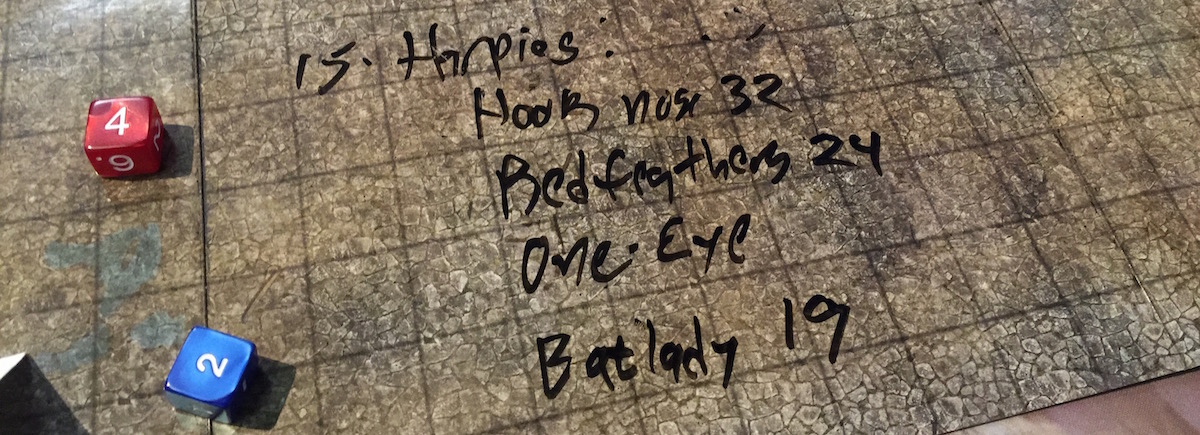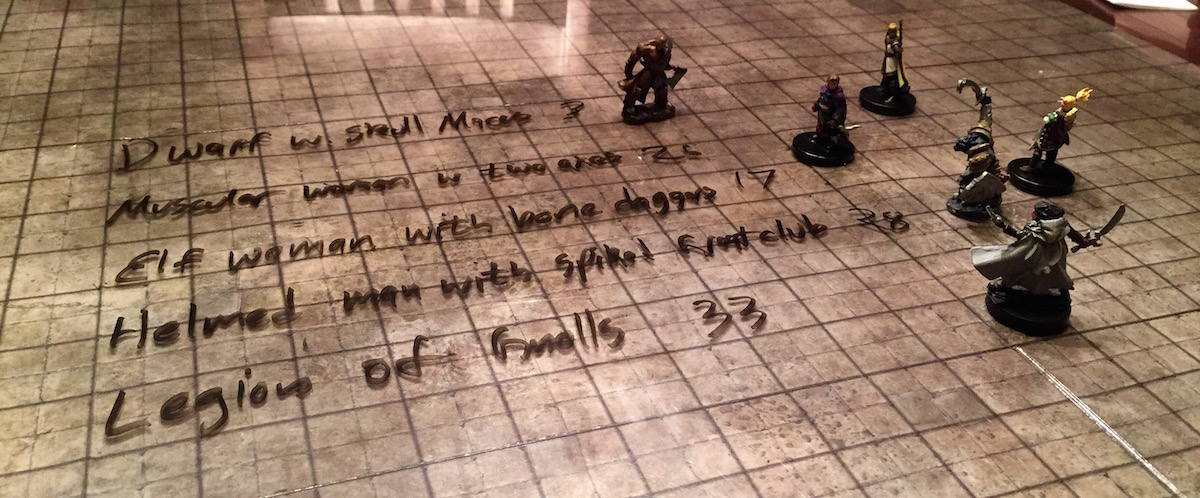New to Sly Flourish? Start Here or subscribe to the newsletter.
A Troll Named Handbag: Player-Driven Monster Identification
by Mike on 28 September 2015
"Four hideous trolls rise from the fetid water. One of them has three arms. One of them has two chattering heads. One of them is badly scarred from fire on one side. What does the fourth look like?"
"Handbag. His name is Handbag."
Every so often we stumble onto a simple but powerful tool that accomplishes a great deal with just a small change in how we play our D&D game. One such tool is the act of asking players to define the physical characteristics of their foes. It sounds small but this act has tons of benefits, some clear and some not so clear. The act itself is easy to do:
When a PC attacks a monster, have the player define a physical identifying trait of that enemy. Then write it down so all of the other players know that foe by that physical trait.
The trait itself can be just about anything. It can be a notable tattoo. It can be a battle scar. It can be an interesting weapon they wield or a religious woad covering their face.

With the trait defined, everyone can now easily identify this foe in a battle, even if you don't have miniatures or other visual aids. This trait becomes it's "name" or even it's Fate-style aspect. It might become a hook you can use in your description of the monster's actions. If a player idenitifies a foe by it's skull-shaped spiked morningstar, imagine how it sounds when that morning star smashes against the stone floor or a fighter's breastplate.
Examples of Physical Traits
These physical traits can be just about anything the PCs might notice. It might be an exotic weapon they wield. It might be a strange tattoo. It might be a hideous scar or some sort of weird mutation. It might be a weird style of hair or armor. This trait is almost a miniature "One Unique Thing", a feature from the RPG 13th Age. The only real rule is that it can't dramatically affect the capabilities of the monster. "This troll has no arms and no eyes" for example, unless its arms are replaced by great scythes and it has learned to blindfight in an arena!
Switching from Left-Brain to Right-Brain Thinking
One awesome side-effect of this trick is to turn a switch in the player's mind from logical and mechanical "left brain" thinking to more creative and imaginative "right brain" thinking. There are a lot of mechanics in our D&D games but there are mountains of often untapped creativity in the brains of the players as well. When we get our players to answer simple questions like this, we help shift them out of the game's mechanics and into imagining the actual situation. Here's another dirty little secret: it's working for you too. As a DM, when we hear other players come up with interesting physical identifiers for monsters, it helps fuel our creativity as well and helps us improvise the whole rest of the game.
Drawing the Noteworthy from the Masses
Another benefit of this technique is that it helps build notable NPCs out of the mass of monsters with no preparation required, a great principal of the way of the Lazy Dungeon Master. Sometimes these identifiers stick out so far in our minds and the minds of the players that they pull this monster out from the rest of the pack. Suddenly Handbag the Troll becomes a key villain the NPCs might face again or even an unforeseen ally to aid them in their journey. These sorts of accidental shifts of attention are a delight to witness and, with the technique of asking players for physical identifiers, easy to serve up.

An Invaluable Aid for Narrative Combat
Running narrative "theater of the mind" combat can be hard to do if you're used to grids and miniatures. Identifying different monsters in a battle without miniatures can frustrate players and befuddle DMs. Player-described monster identifying characteristics are a great way to help everyone understand which monster is which.
You can start off a battle by numbering monsters and listing them out somewhere where everyone can see them. You might write them out on a Pathfinder Flip-Mat sitting right in the center of the table.
When a player chooses to have their PC attack an enemy, ask them to "define an interesting physical characteristic of this enemy". When they have one, replace "monster 1" with that trait, such as "half-jaw" or "nose ring". In a round or two, all of the monsters will have flavorful identifiers instead of numeric ones.
A Small Window Into a Limitless World
D&D as group storytelling has limitless potential. Sitting around in a comfortable environment with our friends has the potential to build fantastic stories well outside the bounds of any single imagination. That is both extremely powerful and extremely frightening. Taking small steps can help all of us regain a bit of the imagination we've lost since childhood and fall into other worlds than this one.
Try taking this small step. Ask your players to identify the physical identifiers of their foes and use it as the spark that may set all of our imaginations ablaze.
Related Articles
- Sly Flourish's Guide to to Narrative "Theater of the Mind" Combat in the 5th Edition of Dungeons & Dragons
- The Tyranny of the Grid
- Creative Mind Exercises for D&D
Subscribe to the Newsletter
Subscribe to the weekly Sly Flourish newsletter and receive a free adventure generator PDF!








